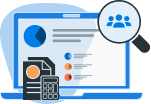What Does Open Enrollment Mean in HR?
Open enrollment is the designated period when employees can modify their benefit elections for the upcoming plan year. Workers can enroll in new benefits, change existing coverage, or opt out of programs without qualifying life events.
This special enrollment period occurs annually, typically lasting several weeks. HR departments coordinate these periods to align with plan cycles and ensure compliance with federal regulations governing employee benefits.
Open enrollment covers health insurance, dental and vision coverage, retirement plans, life insurance, and flexible spending accounts. Employees must actively participate during this window, as benefit elections remain locked for the plan year except for qualifying events.
Organizations use this period to introduce new options, communicate changes, and help employees understand choices through HRMS software platforms.
Why Is Open Enrollment Important for Employees and Organizations?
Open enrollment serves critical functions for both employees and employers, creating structured opportunities for benefit management and workforce planning.
Employee Benefits
Enrollment benefits include the ability to adjust benefit selections based on changing family needs, health conditions, and financial circumstances. Workers can evaluate new offerings, compare plans, and maximize their total compensation value.
This period provides access to comprehensive information and decision-support tools to help employees make informed choices about healthcare, retirement, and supplemental benefits.
Organizational Advantages
Employers can introduce new programs, adjust contribution levels, and gather feedback on benefit preferences. The structured timing allows HR teams to negotiate with vendors and process enrollment data efficiently through payroll management systems.
Open enrollment reduces administrative burden compared to ongoing benefit changes and helps maintain HR compliance with federal regulations including ERISA, COBRA, and ACA requirements.
How Can You Manage Open Enrollment Effectively?
Successful open enrollment requires strategic planning, clear communication, and systematic execution.
Planning and Preparation
Begin planning 6-8 months early to allow time for vendor negotiations and system updates. Create project timelines with clear milestones and review prior year feedback to identify improvements.
Update benefit summaries and communication materials to reflect current offerings and regulatory requirements.
Communication Strategy
Develop comprehensive communication plans using multiple channels including email, intranet, printed materials, and virtual meetings. Provide decision-support tools such as cost calculators and plan comparison charts.
Schedule informational sessions and one-on-one consultations to address employee questions through employee engagement initiatives.
Technology Implementation
Implement user-friendly enrollment platforms that integrate with existing systems. Ensure platforms can handle enrollment volumes and provide real-time confirmation of selections.
Test all technology before launch and provide technical support throughout the process. Mobile-friendly interfaces accommodate employees who prefer smartphone access.
Support Systems
Train HR staff to answer enrollment questions and establish help desk support for technical issues. Consider partnering with benefit vendors for expert consultation during peak periods.
What Benefits Are Typically Included in Open Enrollment?
Employee benefits open enrollment encompasses comprehensive benefit portfolios designed to meet diverse employee needs.
Health Insurance
Medical coverage includes multiple plan tiers, HMO and PPO options, and high-deductible health plans with Health Savings Accounts. Dental and vision insurance often accompany medical coverage with varying premium arrangements.
Retirement Benefits
401(k) plans allow employees to adjust contribution levels and investment allocations. Organizations may provide matching contributions and additional programs like pension plans or deferred compensation.
Insurance Coverage
Life insurance options include basic employer-provided coverage and voluntary supplemental policies. Disability insurance provides income protection for employees unable to work due to illness or injury.
Flexible Spending Accounts
Healthcare FSAs allow pre-tax dollars for medical expenses. Dependent Care FSAs provide tax advantages for childcare and eldercare expenses. These accounts require annual elections that cannot be changed outside qualifying events.
Additional Benefits
Many organizations include wellness programs, employee assistance programs, and voluntary benefits such as legal services and identity theft protection through benefits administration systems.
Common Challenges HR Faces During Open Enrollment?
HR departments encounter predictable challenges requiring proactive planning and strategic solutions.
Employee Engagement
Low participation rates occur when employees make default elections without evaluating options. Complex benefit terminology can overwhelm workers, leading to poor decisions or enrollment avoidance.
HR teams must create compelling communication strategies and simplify messaging to motivate active participation.
Technology Issues
Enrollment platforms may experience technical difficulties during peak usage periods. Integration challenges between enrollment systems and payroll platforms can create data accuracy issues.
Robust testing and contingency planning help prevent system failures and processing delays.
Compliance Requirements
Maintaining compliance with federal regulations requires careful attention to documentation and enrollment procedures. Managing COBRA notifications, ACA reporting, and ERISA compliance adds process complexity.
Regular compliance reviews through employment law updates ensure adherence to requirements.
Resource Constraints
Limited HR staffing during enrollment periods creates bottlenecks and reduces service quality. Budget constraints may limit communication options and technology investments.
Strategic planning and temporary resource allocation help manage workload peaks. Creative solutions such as peer ambassadors and vendor partnerships extend available resources.
Change Management
Introducing new benefits or modifying existing programs requires careful change management to ensure employee acceptance. Vendor changes or system transitions create additional complexity requiring extensive planning.
Clear communication about changes and their rationale helps minimize resistance and ensures smooth transitions.
Ready to streamline your open enrollment process and create exceptional employee experiences? Discover how Qandle's comprehensive HR management platform can automate enrollment workflows, ensure compliance, and provide employees with intuitive benefit selection tools. Start your free 14-day trial today and transform your benefits administration into a strategic advantage.


 Back to Glossary
Back to Glossary